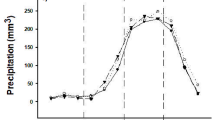Summary
-
1.
Ten male golden-mantled ground squirrels were captured in late summer and maintained in the laboratory for nearly 2 years at constant photo-period (LD 12∶12) and temperature (23 °C). Testes were measured monthly using a new laparotomy technique, and body mass and water consumption were recorded as well.
-
2.
Size of testes showed a precise and well marked endogenous circannual rhythm with a period of about 11 months. The testes developed over a 3-month period during the hibernation phase of the annual cycle and reached a peak in mass by the end of hibernation. Two successive circannual cycles were expressed during the experiment.
-
3.
Circannual rhythms of body mass and water use — which are components of the overall cycle of hibernation and metabolism — persisted concurrently with the circannual testicular cycle and also showed a period of about 11 months. Analysis of phase relationships between the 3 rhythmic parameters measured shows that precise internal synchronization of these independent rhythmic functions is maintained. The annual peak in body mass occurred about 3 months before the peak in testis size. The minimum of water use — an indication of annual metabolic minimum associated with hibernation — occurred about one month before the testis peak.
-
4.
The duration, annual phasing, and predictability of aboveground environmental conditions which favor successful reproduction have strongly shaped the evolution of reproductive performance in golden-mantled ground squirrels and have promoted endogeneity, precision, and brevity of breeding condition in the annual cycle of these animals. Further problems in the evolution of this rhythmic system and in its mechanisms are discussed.
Similar content being viewed by others
References
Blake, B.H.: The annual cycle and fat storage in two populations of golden-mantled ground squirrels. J. Mammal.53, 157–167 (1972)
Broadbooks, H.E.: Populations of the yellow-pine chipmunk,Eutamias amoenus. Am. Midl. Nat.83, 472–488 (1970)
Bronson, M.T.: Altitudinal variation in the life history of the golden-mantled ground squirrel (Spermophilus lateralis). Ecology60, 272–279 (1979)
Davis, D.E.: Hibernation and circannual rhythms of food consumption in marmots and ground squirrels. Q. Rev. Biol.51, 477–506 (1976)
Goss, R.J., Dinsmore, C.E., Grimes, L.N., Rosen, J.K.: Expression and suppression of the circannual antler growth cycle in deer. In: Circannual clocks. Pengelley, E.T. (ed.), pp. 393–422. New York: Academic Press 1974
Gwinner, E.G.: Adaptive functions of circannual rhythms in warblers. Proc. XV Intl. Ornithol. Congr., 218–238 (1972)
Gwinner, E.: Circadian and circannual rhythms in birds. In: Avian biology. Farner, D.S., King, J.R. (eds.), pp. 221–285. New York: Academic Press 1975
Gwinner, E.: Photoperiodic synchronization of circannual rhythms in the European starlingSturnus vulgaris). Naturwissenschaften64, 44 (1977)
Heller, H.C., Poulson, T.E.: Circannian rhythms — II. Endogenous and exogenous factors controlling reproduction and hibernation in chipmunks (Eutamias) and ground squirrels (Spermophilus). Comp. Biochem. Physiol.33, 357–383 (1970)
Howell, A.H.: Revision of the North American ground squirrels, with a classification of the North American Sciuridae. North Am. Fauna56, 1–247 (1938)
Ingles, L.G.: Mammals of the Pacific States, 506 pp. Stanford: Stanford Univ. Press 1965
Kenagy, G.J.: Rapid and repeatable surgical technique for measurement of testis size in small mammals. J. Mammal.60, 636–638 (1979)
Kenagy, G.J., Bartholomew, G.A.: Effects of day length and endogenous control on the annual reproductive cycle of the antelope ground squirrel,Ammospermophilus leucurus. J. Comp. Physiol.130, 131–136 (1979)
McKeever, S.: The biology of the golden-mantled ground squirrel,Citellus lateralis. Ecol. Monogr.34, 383–401 (1964)
Mrosovsky, N.: Circannual cycles in hibernators. In: Strategies in cold: natural torpidity and thermogenesis. Wang, L., Hudson, J.W. (eds.), pp. 21–65. New York: Academic Press 1978
Pengelley, E.T. (ed.): Circannual clocks. 523 pp. New York: Academic Press 1974
Pengelley, E.T., Asmundson, S.J.: Circannual rhythmicity in hibernating mammals. In: Circannual clocks. Pengelley, E.T. (ed.), pp. 95–160. New York: Academic Press 1974
Pengelley, E.T., Fisher, K.C.: The effect of temperature and photo-period on the yearly hibernating behavior of captive golden-mantled ground squirrels (Citellus lateralis tescorum). Can. J. Zool.41, 1103–1120 (1963)
Tevis, L.: Stomach contents of chipmunks and mantled squirrels in northeastern California. J. Mammal.34, 316–324 (1953)
Author information
Authors and Affiliations
Additional information
I thank B. Barnes and T. Horton for their assistance with this study. Financial support was provided by a grant from the University of Washington Graduate School Research Fund and by National Science Foundation Grants PCM 77-05397 and DEB 77-06706.
Rights and permissions
About this article
Cite this article
Kenagy, G.J. Interrelation of endogenous annual rhythms of reproduction and hibernation in the golden-mantled ground squirrel. J. Comp. Physiol. 135, 333–339 (1980). https://doi.org/10.1007/BF00657649
Accepted:
Issue Date:
DOI: https://doi.org/10.1007/BF00657649



